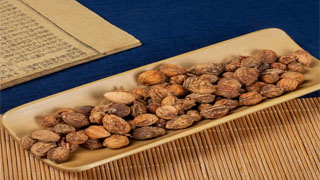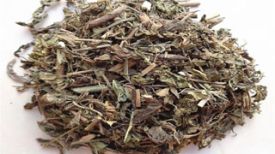
1. Alias
Yizhi Zi, Yizhi Ren, and Tiaoyu Zi.
2. Plant morphology
Perennial herb. The rhizome runs horizontally, the stem stands upright, and grows in clusters. Two rows of leaves, with a wide lanceolate shape, a pointed tip at the tip, a wide wedge-shaped base, and fine serrations and shedding small hairs on the edges. The upper part is dark green and the lower part is light green; Short petiole; Leaf tongue membranous, brown, 2-lobed. Flowers bisexual, inflorescence terminal, covered in short hairs, with one circular bract at the lower end, surrounding the axis of the flower, short bract, membranous, brown; Calyx tube shaped, with a 3-lobed tip and one side splitting to the middle, covered in short hairs. The corolla tube has 3 lobes, oblong in shape, slightly larger on top, with a slightly rounded tip and sparse soft hairs on the outside. The lip is ovate in shape, pink white with red stripes, blunt at the tip, 3-lobed, with a prominent middle lobe and wavy edges; The degenerated stamens are short cone-shaped, with one developing stamen, flat and linear filaments, short and round anthers, and a round cockscomb appendage at the apex of the stamen septum; The ovary is located in the lower part, with 3 chambers, oval in shape, densely covered with hairs, and has 2 rod-shaped appendages at the upper end. Each chamber has 8-9 ovules, and the style is slender with a head like stigma and sparse hairs. The capsule is elliptical in shape, with narrow and pointed ends, sparsely hairy or smooth, and has obvious longitudinal vascular bundles on the surface of the skin. The fruit stalk is short, and when ripe, the fruit is yellow green to brown. The seeds are mostly polygonal, slightly flattened, brownish black, and have a false seed coat. The flowering period is from January to March, and the fruiting period is from March to June.
3. Origin distribution
Born in damp and shady areas under the forest. Distributed in Yangjiang and Leizhou Peninsula in Hainan and Guangdong. In addition, there is cultivation in Fujian and Guangxi.
4. Harvesting and processing
Pick the fruits from May to June when they turn green to red, and dry them in the sun or at low temperatures.
5. Characteristics of medicinal herbs
Elliptical, slightly pointed at both ends. The surface is brown or gray brown, with vertically uneven raised edges, and there are floral residues at the top. The base often has residual fruit stalks. The skin is thin and slightly tough, tightly attached to the seed, and the seed aggregates into a cluster with a membrane dividing the cluster into three petals. The seeds are irregularly flattened, slightly blunt edged, with a surface that is gray brown or gray yellow, and covered with a light brown membranous false seed coat; Hard texture, white endosperm. It has a unique aroma, a spicy taste, and a slight bitterness.
6. Sexual Taste Returning to the Classics
Warm in nature, pungent in taste. Returning to the Spleen Meridian and Kidney Meridian.
7. Effect and Function
Warm the spleen to stop diarrhea, absorb saliva, warm the kidneys, consolidate essence and reduce urine. Belonging to the subcategory of astringent drugs, it is a type of tourniquet that solidifies essence, shrinks urine, and stops bleeding.
8. Clinical application
Take 3-9 grams and decoct. Used to treat spleen cold diarrhea, abdominal cold pain, excessive salivation, kidney deficiency enuresis, frequent urination, and white turbidity of nocturnal emissions. Yizhi Zi, stir fry and grind finely, drink rice with salt for 1 yuan, and treat women's collapse ("Jing Xiao Chan Bao").
9. Pharmacological research
Inhibit the Na+- K+pump in the myocardium; Has a cardiotonic effect; Expand blood vessels; Anti gastric injury; Inhibit the ileum; It has inhibitory effects on prostaglandins and other substances.
10. Chemical composition
Containing 2% volatile oil, the composition is extremely complex, with dozens of different types. It also contains the heart strengthening ingredient Yizhiren ketone A and the stimulating ingredient Yizhiren ketone B, the calcium antagonist Yizhichun, and the anti ulcer ingredients Yizhitong, gingerene, gingerol, caryophyllene, etc.
11 Usage taboos
This product is dry and hot, and can harm yin and help with fire. Therefore, it should be avoided for those with yin deficiency and excessive fire, or those who suffer from symptoms such as nocturnal emissions, frequent urination, and collapse due to heat.
12. Compatibility prescription
① Treating enuresis during pregnancy: divide equally into Yizhiren, Baiwei, and Baishao. At the end. Take 9 grams per serving, add 0.9 grams of salt, and adjust to the rolling white soup. (Dantai Jade Case)
② Treat enuresis in children and also treat turbidity: divide Yizhi Ren and Baifu Ling into equal parts. Above is the end. Take 3 grams each time and adjust the hollow rice soup. ("Supplement to Pocket Prescriptions for Children" Yizhi Ren San)
③ Treating red and turbid urine: 60 grams each of Yizhi Ren and Fushen, 240 grams each of Yuanzhi and licorice (boiled in water). For the end, wine paste pills, wutong son big. Fifty pills of hollow ginger soup. (Gangmu)
④ Treating Women's Collapse: Improve intelligence, stir fry until fine, drink rice with salt and take 3 grams. (Jingxiao Chanbao)
⑤ Treating fetal bleeding: 15g of Yizhi Ren and 30g of Shousha Ren, as the final ingredients. Take 9 grams per dose. Under the hollow white soup, take it twice a day. (Hu's "Ji Yin Fang")
⊙ The content of the article is for clinical reference only. Non TCM professionals are not allowed to test drugs.


